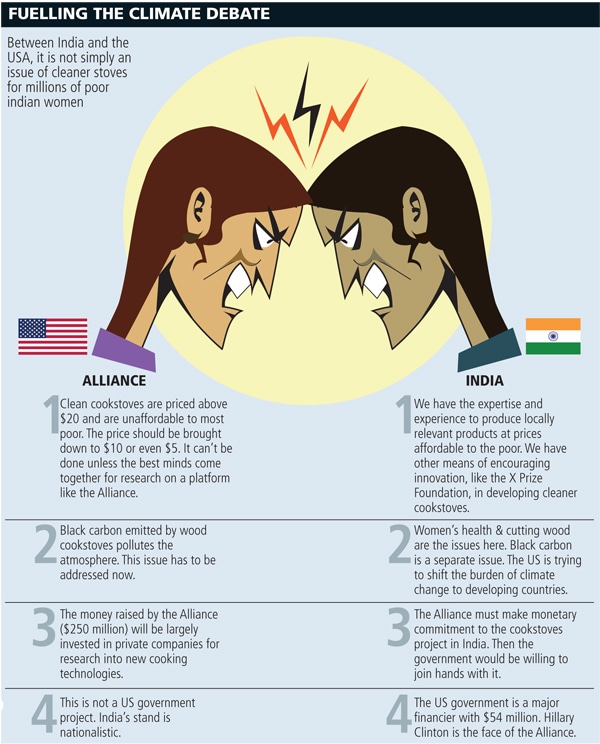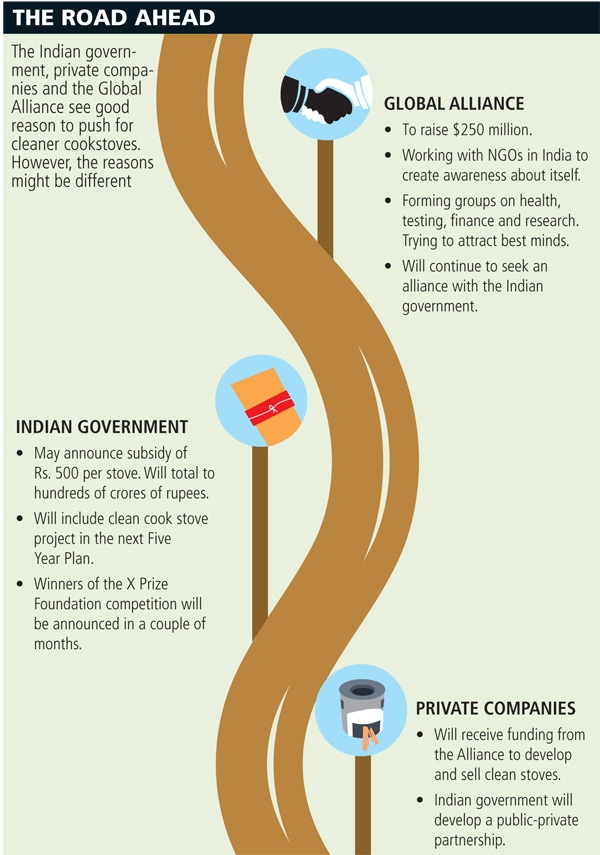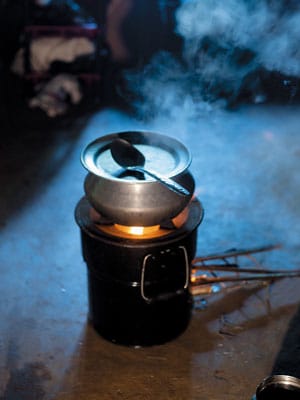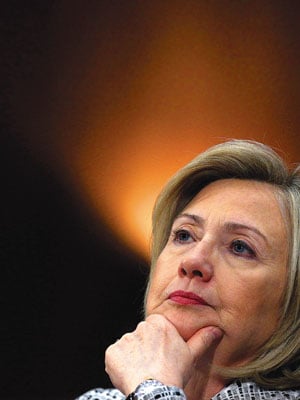
Why Is Hillary Clinton Peeping into Indian Kitchens?
The US Secretary of State helped launch a global initiative to provide poor women with cleaner cookstoves. India is not convinced about the motives
There is little in common between US Secretary of State Hillary Clinton and Sindhu, a village belle who lives 14,000 kilometres away in South India. Sindhu is a primary school dropout, who hardly ventures out of her hamlet. She spends most of her time in daily chores such as cooking, washing and keeping the family hog pen with a lone animal. She knows nothing of international power politics or cross-border economic battles.
Yet, both Clinton and Sindhu have become the central characters in a simmering international dispute between American and Indian interests. It is not an explosive, headline-grabbing trade war of sorts, but tacit hostility that is carried out in whispers. At stake is everything from the struggle against climate change and loss of forests to providing a healthier lifestyle to women in the developing world.
And all the fire started from the humble cookstove.
Sindhu belongs to a family of coffee plantation workers, in the village of Balayagudi in the picturesque Coorg district of Karnataka. A five-foot wall divides her one-room hut into kitchen and living area. Till recently, she used to shed copious tears as she cooked for a family of seven with a stove that burnt wood quite inefficiently and filled up her house with smoke. One day, BAIF Development Research Foundation (a voluntary organisation founded by Manibhai Desai, a follower of Mahatma Gandhi) gave her a stove that burnt wood more efficiently and led to less smoke, tears and carbon black.
Sindhu is just one of the few million lucky women to have escaped from the wretchedness of the slow-burning, smoky stove. For many more millions, almost all of them women, the traditional wood stove called chulha is the only option to cook. You must blow to get the wood to burn enough and wait interminably as the heat slowly spreads through the vessel. Even then, less than a fifth of the wood converts into heat energy, the rest becoming smoke and soot. But you sit alongside, stirring the pot, mixing the vegetables and choking your lungs in the process. Do it for years and you could get a number of serious diseases including cancer.
There are about 160 million households across India where this is a daily occurrence. As many as 570,000 women and children die prematurely each year due to chulha smoke, a joint study by University of California, Berkeley, and Indian Institutes of Technology has revealed. These families are too poor to afford cooking gas connections, despite the government’s subsidy. They depend on wood for fuel, as it is locally available and they can’t buy anything else.
The government realised the enormity of this problem as early as 1985, when it launched a scheme to provide low-smoke stoves to poor families. In the following 17 years, the government distributed stoves free to 30 million households. But then, being a freebie offer, it was a very expensive undertaking for the government. The technology wasn’t good either and the stoves were found to be offering “low durability, usage and performance.” As a result, the scheme was wound up in 2002. Even as more and more Indians bought LPG stoves (there are 122 million gas connections in the country now), a substantial part of the country still depended on chulhas for which the government needed to evolve a separate solution. But it was clear that it had to be viable and market-based.
Two years ago, the ministry of new and renewable energy (MNRE) launched the National Biomass Cookstoves Initiative (NBCI) to explore public-private partnership to take cleaner stoves to those millions. The government wanted to work with those who can help it scale up the project to the gigantic levels India needs. It also needed a lot of money.
It was then that a global alliance that Hillary Clinton helped to launch came into the picture.
A Smokescreen?
Wood stoves contribute to massive cutting down of trees and the smoke is a major pollutant in the developing world. To fight this menace, and to ensure an easier workday for women, Clinton launched the Global Alliance for Clean Cookstoves in New York. The US government gave $54 million for the initiative. Based in Washington, D.C., the Alliance aims to raise $250 million in all. It counts among its founders departments of the US government, UN agencies and those from the corporate world such as Morgan Stanley and Shell Foundation. “The purpose is to create a global resource, research and technology base that will support efforts at the grassroots,” says Shell Foundation’s Simon Bishop, deputed by his organisation to the management of the Alliance.
This is a high-brow list and it looked equal to the task of the smoking-stove problem that affects 500 million families and kills 1.9 million people a year around the world. But when the Alliance went to the single largest market for clean stoves — India — and invited the government to join its initiative, it was politely declined.
Indian officials, speaking to Forbes India on the condition of anonymity, said they rejected the Alliance’s proposal because its agenda could have implications going far beyond fixing the village woman’s kitchen. They said it revealed one facet of efforts by the developed world to shift the burden of climate change to the developing world and absolve itself of primary responsibility for controlling emissions.

Infographics: Sameer pawar
Just like carbon-dioxide (CO2) let out by industrial chimneys, the black carbon emitted by cookstoves is also a contributor to worldwide pollution. “Black carbon is a politically sensitive issue,” says a senior Indian official. Till now, CO2 has been recognised as the main culprit and its major producers, the industrialised nations, are under pressure to cut down emissions. But carbon black is almost entirely a developing world phenomenon. “So, by highlighting black carbon emissions, the whole climate change issue can be turned on its head by saying that the onus is on the developing countries to reduce emissions,” says the official. “And this will dilute the responsibility of developed nations, like the US, to reduce emissions.”
India thinks the Alliance is basically a joint effort by the US government and American industry to help the climate change stance of the US. “With the US government being the major sponsor, coupled with the fact that it was launched by Clinton, the initiative completely takes a political flavour,” says an MNRE official.
A representative of one of the founding members of the Global Alliance admitted that climate change is a focus area. At the same time, “this should not be seen as a US government initiative,” he said. He termed India’s stance “a little nationalistic.”
Show Me the Money
One selling point for the Alliance could have been money, but Indian officials say that it has not committed any investment so far. That would mean that the Alliance would attach itself to a project that is already running in India with local money. The Americans will “take over the initiative on the global stage and take credit for work in India and hog the limelight, especially given the fact that they have done little on climate change,” the official says.
While the Indian government typically subsidises the purchase of stoves by poor women, the Alliance wants to spend its money on research. “Part of the funds raised will be used to invest in private companies that are developing stoves,” says Bishop of Shell Foundation.
The Alliance has already formed working groups on health, technology, finance and carbon finance. A sum of $24 million will go to health research and another $12.5 million for technology and fuel research.

Infographic: Sameer Pawar
But cookstoves are not rocket science and India doesn’t think that it needs external help to make them work. In a written statement to Forbes India, MNRE said “India has adequate expertise and capacity to develop and deploy efficient and cost-effective biomass cookstoves utilising the locally available biomass fuel.”
Shyam Saran, former foreign secretary and India’s lead negotiator on climate change, says India’s priority is to provide affordable sources of energy to its rural population. “We would prefer to drive our mission based on our own priorities and the specificity of Indian conditions.”
But the government has not been entirely xenophobic when it comes to its cookstove project. Along with IIT Delhi and the US-based X Prize Foundation, the government launched a global competition last year to develop next-generation clean cookstoves. X Prize is a non-profit that administers high-profile global competitions with prizes of up to $30 million. The results of the cookstove competition will be out in the next couple of months.
MNRE has also set up four testing centres across the country to run quality checks on stove models that hit the market. Talks are also on to standardise stove features. The government may also announce an exclusive clean stove policy this year. The project could then be included in its Five Year Plans.
The private sector is gearing up to meet the demand too. Companies such as First Energy, Envirofit and ARTI now claim their stoves to be more than 300 percent more efficient than traditional stoves, reducing smoke emission by 70 percent.
From models that initially weighed more than 50 kg, these stoves have evolved into sleek 5-kg appliances. New entrepreneurs are jumping in too. Engineer Mouhsine Serrar felt stifled in his job at Shell Foundation; he quit and set up Prakti Design in Puducherry to develop clean stoves. He has now tied up with green energy firm Selco to market them.
It is this confluence of objectives of both the public and private sectors that gives the government the confidence that it can handle the job alone. However, the Alliance believes a ‘comprehensive global partnership’ is needed to bring down the prices of clean stoves to the affordable levels of $10 per piece or even $5.
It has a point. Today, despite all their reputation for frugal engineering, Indian companies sell cleaner, wood-burning cookstoves in the range of Rs. 900 ($20) to Rs. 5,000 ($110). This is far too costly for the families that really need them. Even for Sindhu, her family’s income from plantation labour and honey-gathering couldn’t have been enough to buy a stove at this price. She got one free.
After the government’s rebuff, the Alliance is said to be working with voluntary groups to take its work to India. But it still remains keen to join hands with the government. Bishop of Shell Foundation concedes that the formation of the Alliance might have been a ‘little rushed’ and its role in India has not been explained in detail. So, all it needs to melt hearts in New Delhi is better communication, and a willingness to write a cheque.
(Edited by S. Srinivasan)
(This story appears in the 30 November, -0001 issue of Forbes India. To visit our Archives, click here.)






